It's true that making a Sozoom image in the first place is a little promotional (for Nokia), and also for Sozoom's developer, but there's also a certain satisfaction in seeing just what your smartphone's camera is capable of - and communicating this to family and friends who otherwise might not believe you.
The idea, then, is to shoot a photo, then pluck out one or two interesting details that you couldn't see properly in the 5MP shareable image - and certainly not on-screen. The end result is then saved and shared as appropriate.
Several Sozoom examples have been sent in to me for possible inclusion in articles, but in each case there was something not really optimised and I thought a quick 'how to' might be helpful.
- Make sure your device has the latest firmware. The Lumia Black firmware included dramatic imaging improvements - certainly for the 1020 - and the resolved detail in your Sozoom magnifying glass(es) may well be significantly better after the update.
- Make sure there's enough light - a low light scenario will need all your device's PureView oversampling in order to get rid of noise, so there's no point in using Sozoom, which will just show up a noisy 'raw' patch in the underlying image(!):

- Try to make sure that the items you intend to pluck out for Sozoom 'magnification' are at roughly the same distance (they're usually far away, anyway, by the very nature of what we're doing here, though see the phone macros example below to show that closer subjects are possible).
- Bearing in mind the previous point, make sure that your photo isn't focussed on something at a different distance, e.g. on a person or object in the near-to-medium foreground. Get this wrong and all you may be magnifying in the distance are blurry, slight out of focus pixels!
- Don't fiddle with the zoom silder in the interface - when you increase this over 1x, you're applying traditional 'lossy' digital zoom techniques to the underlying photo detail. So things will seem bigger, but you don't actually get any more detail and you just end up with a blocky, fuzzy circle of pixels.
- When positioning the Sozoom 'magnifying glasses', try not to have too many of them, try not to have the conical paths crossing, and try to position the magnified sections so that they don't blot out non-magnified content you do want viewers to see.
With all this in mind, there's no reason why you can't produce some splendid Sozooms. Here's a few of mine that I've been playing around with, in preparing this short tutorial:
(note that each of them is the full exported version, but just resized in your browser - use 'Open in tew tab' or 'Save as' or similar in order to see the full 1600 pixel wide image)




Feel free to include any Sozoom examples of your own (that you're proud of) below in the comments. Do you have any other tips that could help others?
PS. You can buy Sozoom here in the Windows Phone Store, for less than a pound, Euro or dollar. The trial version only allows one small 'magnifying glass', but it'll give you enough of an idea as to whether you want to buy the full application.
PPS. Also, regardless of the fun you're having with Sozoom, do bear in mind again that the maximum quality you'll get from your Lumia for distant items, is by zooming at capture time rather than 'later'.
